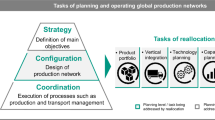Abstract
The increasingly global market and the international organization of manufacturing companies demand efficient and effective configuration of the operational production network. However, the prerequisites for a successful reorganization of the production network are frequently inadequately analyzed and taken account of. The outsourcing and relocation of production and assembly capacities solely for reasons of (labor) costs turns out to entail economic risks and to be too short-sighted strategically. The systematic approach of the global variant production system (GVP) presented here is intended to enable companies to operate globally and at the same time retain, even expand, their core competencies at the home location. The GVP system is the result of a joint research project sponsored by the Federal Ministry of Education & Research (BMBF) and carried out by the Institute of Production Systems and Logistics (IFA) in cooperation with the Institute of Integrated Production Hannover (IPH), the Sociological Research Institute Göttingen (SOFI) and different companies from industry.








Similar content being viewed by others
References
Abele E et al (2008) Global production: a handbook for strategy and implementation. Springer, Berlin
Lay G, Kinkel S, Eggers T et al (2001) Leitfaden Globalisierung erfolgreich meistern. VDMA Verlag, Frankfurt
Nyhuis P, Nickel R, Tullius K (2008) Globales Varianten Produktionssystem—Globalisierung mit System. PZH Produktionstechnisches Zentrum GmbH, Garbsen
Kinkel S, Wengel J (1998) Produktion zwischen Globalisierung und globaler Vernetzung. Mitteilungen aus der Produktionsinnovationserhebung, Fraunhofer Institut Systemtechnik und Innovationsforschung, 10
Mühlenbruch H (2008) Produktmodell für globale Produktionsstufen. Diss. Leibniz Univ. Hannover, PZH Produktionstechnisches Zentrum GmbH, Garbsen
Von Cieminski G, Nyhuis P (2007) Modeling and analyzing logistic inter-dependencies in industrial-enterprise logistics. Prod Eng Res Dev 1(4):407–413
Wiendahl HP, Gerst D, Keunecke L (2003) Variantenbeherrschung in der Montage–Konzept und Praxis der flexiblen Produktionsendstufe. Springer, Berlin
Alford D, Sackett P, Nelder G (2000) Mass customization—an automotive perspective. Int J Prod Econ 65(2000):99–110
Großhennig P, Große-Heitmeyer V (2008) Globalization-compatible product structure based on technological core competencies. In: Mitsuishi M, Ueda K, Kimura F (eds) Manufacturing systems and technologies for the new frontier. Springer, London
Nyhuis P, Großhennig P, Mühlenbruch H (2006) Das Globale Varianten Produktionssystem—Eine Globalisierungsstrategie für kleine und mittelständische Unternehmen. ZWF Zeitschrift für wirtschaftlichen Fabrikbetrieb 101(5):282–286
Rother M, Shook J (2007) Learning to see. The Lean Enterprise Institute, Brookline
Erlach K (2007) Wertstromdesign—Der Weg zur schlanken Fabrik. Springer, Berlin
Hines P, Holweg M, Rich N (2004) Learning to evolve—a review of contemporary lean thinking. Int J Oper Prod Mgmt 24(10):994–1011
Jones D, Womack J (2003) Seeing the whole—mapping the extended value stream. The Lean Enterprise Institute, Brookline
Ellram LM (1993) A framework for total cost of ownership. Int J Log Mgmt 4:49–60
Ellram LM (2002) Total cost of ownership. In: Hahn D, Kaufmann L (eds) Handbuch Industrielles Beschaffungsmanagement. Gabler-Verlag, Wiesbaden, pp 659–671
Peters S, Reinhardt K, Seidel H (2006) Wissen verlagern—Risiken und Potenziale von Standortverlagerungen. Gabler Verlag, Wiesbaden
Foussier P (2006) From product description to cost: a practical approach-vol 1: the parametric approach. Springer, London
Christopher M (2005) Logistics and supply chain management—creating value adding networks, 3rd edn. Prentice-Hall, New York
Hoefle M, Marquart H, Schnopp R (2007) Outsourcing—Wozu? Irrweg oder Ausweg. Managerismus: Pathologien deutscher Unternehmen, München
Großhennig P, Wagner C, Nyhuis P (2008) Gestaltung globaler Produktionsnetzwerke. ZWF Zeitschrift für wirtschaftlichen Fabrikbetrieb 103(5):299–303
Gausemeier J, Fink A, Schlake O (1996) Szenario-Management: Planen und Führen mit Szenarien, 2nd edn. Carl Hanser Verlag, München
Van der Heijden K (2005) Scenarios—the art of strategic conversation, 2nd edn. Wiley, West Sussex
Ohno T (1988) Toyota production system: beyond large-scale production. Productivity Press, New York
Große-Heitmeyer V (2006) Globalisierungsgerechte Produktstrukturierung auf Basis technologischer Kernkompetenz. Diss. Leibniz Universität Hannover. PZH Produktionstechnisches Zentrum GmbH, Garbsen
Author information
Authors and Affiliations
Corresponding author
Rights and permissions
About this article
Cite this article
Wagner, C., Nyhuis, P. A systematic approach to analysis and design of global production networks. Prod. Eng. Res. Devel. 3, 295–303 (2009). https://doi.org/10.1007/s11740-009-0167-z
Received:
Accepted:
Published:
Issue Date:
DOI: https://doi.org/10.1007/s11740-009-0167-z




